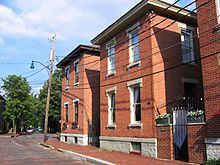German Village
German Village , originally called the old sud end , is a historic district in Columbus (Ohio) , the capital of the state of Ohio , USA .
history
The German Village is one of the most popular residential areas in the city and was built by German immigrants in 1820 . At times, the German population made up a third of the city of Columbus. The German Village experienced its decline during the First World War , when the mood in the USA was directed against people of German origin and the practice of German culture was banned in Ohio , and during Prohibition , when the breweries had to be closed.
In the 1960s, parts of the district were demolished to make way for new construction projects. However, this led to a rescue initiative by residents and the founding of the "German Village Society" and "German Village Commission", which restored the historic district with private funds, so that today there are around 1,600 restored buildings and a lively urban life in which among other things also traditions like the Oktoberfest are cultivated. The architecture of the buildings in German Village shows the Italianate style . German Village is the largest historic district in the USA on the “National Register of Historic Places”, the preservation of which is financed from private funds.
Churches
- St. John's Church
- St. Paul's Evangelical Lutheran Church
- St. Mary's Church
- Trinity Lutheran Church
- Zion Lutheran Church
- Holy Cross Catholic Church
- Livingston United Methodist Church
Attractions
The sights of the German Village include the Schiller Park and Schmidt's Sausage House, in which sausages with sauerkraut are prepared according to a German recipe.
gallery
See also
- German Village (Dugway proving ground)
- Dogil Maeul (German village in South Korea )



